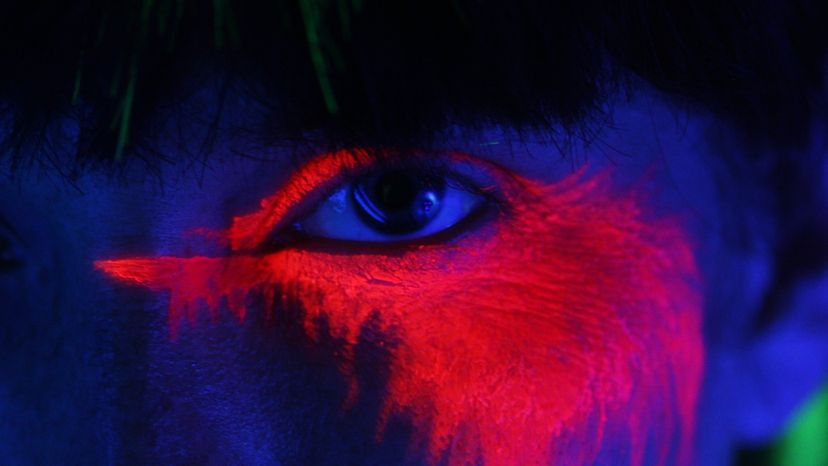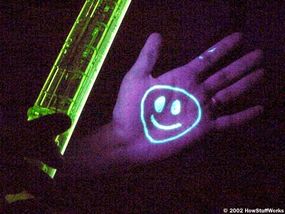How To Fix Ilife V7s Robot Red Light And Stop Working

Y'all take probably seen blackness lights at amusement parks, science museums and Halloween displays. Black lights may expect just like normal fluorescent lamps or incandescent light bulbs, only they do something completely dissimilar. Switch 1 on, and white clothes, teeth and various other things glow in the dark.
For instance, if you lot have a fluorescent affiche and shine a black light on it in a nighttime room, the poster will glow brightly. You may take also seen pieces of paper that look blank in regular light but spell out a glowing message under a black light. Many entertainment parks utilize hand stamps that are invisible until you view them under black light.
In this commodity, we'll find out exactly what'south going on here. We'll also encounter why black lights make some objects glow but not others, and we'll expect at some interesting blackness light applications.
What Is "Black Light"?
If you turn on a blackness light bulb in a dark room, what you can meet from the bulb is a purplish glow. What you lot cannot see is the ultraviolet light that the bulb is also producing.
Our optics can see visible light in a spectrum ranging from blood-red through orange, yellow, green, bluish and violet. To a higher place violet is ultraviolet calorie-free, which we cannot encounter. How Sunburns and Sun Tans Work discusses ultraviolet low-cal and its effects on our skin. A black low-cal bulb produces UVA light (as opposed to UVB light, which is much more harmful).

What yous see glowing under a blackness light, whether on a fluorescent poster or an invisible hand stamp or a newly done white T-shirt, are phosphors.
A phosphor is whatever substance that emits visible low-cal in response to some sort of radiations. A phosphor converts the free energy in the UV radiation from a black calorie-free into visible low-cal.
In the next section, we'll see how phosphors are used in regular fluorescent lighting and in black lights.
Blackness Light Designs
The conventional black light design is just a fluorescent lamp with a couple of important modifications. Fluorescent lamps generate calorie-free by passing electricity through a tube filled with inert gas and a small amount of mercury. (See How Fluorescent Lamps Work for more information.)
When energized, mercury atoms emit energy in the grade of light photons. They emit some visible light photons, but mostly they emit photons in the ultraviolet (UV) wavelength range. Because UV light waves are invisible to the human being eye, fluorescent lamps take to catechumen this energy into visible light. They do this with a phosphor coating around the outside of the tube.
Phosphors are substances that give off calorie-free -- or fluoresce -- when they are exposed to light. When a photon hits a phosphor atom, ane of the phosphor'southward electrons jumps to a higher energy level, causing the atom to vibrate and create oestrus. When the electron falls back to its normal level, it releases energy in the form of some other photon. This photon has less free energy than the original photon, considering some free energy was lost equally oestrus. In a fluorescent lamp, the emitted low-cal is in the visible spectrum -- the phosphor gives off white lite nosotros can see.
Black lights piece of work on this same principle. There are really ii different types of blackness light, but they work in basically the same fashion.
- A tube blackness low-cal is a basically a fluorescent lamp with a different sort of phosphor coating. This blanket absorbs harmful shortwave UV-B and UV-C lite and emits UV-A light (in the same basic way the phosphor in a fluorescent lamp absorbs UV light and emits visible light). The "black" glass tube itself blocks most visible light, and then in the end but benign long-wave UV-A light, along with some blueish and violet visible low-cal, passes through.
- An incandescent black lite bulb is similar to a normal household light bulb, merely it uses light filters to absorb the light from the heated filament. It absorbs everything except the infrared and UV-A calorie-free (and a footling scrap of visible light).
In both of these light designs, the emitted UV calorie-free reacts with various external phosphors in exactly the same way as the UV light within a fluorescent lamp reacts with the phosphor coating. The external phosphors glow as long every bit the UV calorie-free is shining on them.
In the next department, we'll run across what kinds of objects contain phosphors, and we'll look at some interesting uses for black lights.
Blackness Calorie-free Uses
If you walked around all dark with a portable black light, you would discover that at that place are phosphors all over the identify. There are lots of natural phosphors, in your teeth and fingernails, among other things. At that place also a lot of phosphors in manmade material, including goggle box screens and some paints, material and plastics. About fluorescent colored things, such as highlighters, contain phosphors, and you'll find them in all glow-in-the-nighttime products. Clubs and amusement parks apply special blackness low-cal paint that glows different colors. You can besides buy fluorescent black light bubbles, invisible black light ink, fluorescent black calorie-free carpet and even fluorescent blackness light hair gel.

In addition to making people and fluorescent posters look absurd, black lights have some applied applications. For example:
- Appraisers employ them to discover forgeries of antiques. Many paints today contain phosphors that will glow under a black calorie-free, while almost older paints practice not comprise phosphors.
- Repairmen utilize them to find invisible leaks in machinery -- they inject a picayune fluorescent dye into the fuel supply and illuminate it with a blackness lite. For example, they might find an invisible air conditioner leak by adding fluorescent dye to the refrigerant. Black lights can be used to find apocryphal bills.
- Law enforcement officers can use them to identify counterfeit coin. The United States and many other countries include an invisible fluorescent strip in their larger bills that only shows up under a black light.
- Amusement parks and clubs utilize them to identify invisible fluorescent hand stamps for readmission.
- Forensic scientists employ them to analyze crime scenes. To pick out fingerprints, for case, they often grit with fluorescent dye nether a black low-cal. This makes it easier to pick the fingerprints out from surrounding dirt. Black lights can also place semen and other bodily fluids that naturally fluoresce.
Most of these uses, also every bit dozens of others, follow a common theme -- the black lights make the invisible visible or isolate one specific substance from everything around it. When you lot call back about it, in that location are dozens of situations where you could put this miracle to work. The applications are potentially endless!
For more information on black lights and other sorts of light energy, check out the links below.
Originally Published: Jul 18, 2002
Blackness Light FAQ
Are black lights bad for you lot?
Limited exposure shouldn't cause any bug, but prolonged eye contact without eye protection tin cause retina harm.
Is UV light the same as a black light?
Black light is a type of UV lite that emits ultraviolet radiation. This radiations has a shorter wavelength than violet lite, which is the shortest wavelength of light in the visible component of the electromagnetic spectrum.
Tin black calorie-free detect germs?
No, black lite cannot reveal bacteria or other germs.
Why do they call it a black calorie-free?
Black light shows by and large ultra violet or "black" lite, hence its name, but "leaks" purplish calorie-free.
What shows under black light?
Thiamine, riboflavin, niacin, fluids and vitamins polish under black calorie-free. Urine, semen and blood contain fluorescent molecules, and then they as well evidence up under blackness light. Interestingly, some cleaners and laundry detergents, scorpions, tonic water and antifreeze and teeth whiteners all also glow under blackness calorie-free.
Lots More Information
How To Fix Ilife V7s Robot Red Light And Stop Working,
Source: https://science.howstuffworks.com/innovation/everyday-innovations/black-light.htm#pt2
Posted by: gillhamboyaceing.blogspot.com


0 Response to "How To Fix Ilife V7s Robot Red Light And Stop Working"
Post a Comment